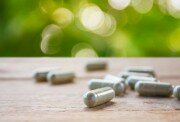Migraines: Discover how to break free of the vicious cycle of migraine attacks
Anyone who has ever suffered the excruciating pain of migraines knows just how debilitating an attack can be lasting anything from several hours to up to a day or, in some cases, even longer! According to the charity Migraine Action Association the condition affects six million people in the UK alone.
The most common migraine symptom is a severe, throbbing pain, usually on one side of the head only, which can be accompanied by nausea, sometimes with vomiting, and extreme sensitivity to light and noise.
At the first sign of an attack, many sufferers reach for painkillers. However, they are only able to temporarily alleviate symptoms and are not always strong enough to reduce migraine pain effectively. Even if they do succeed in relieving pain for a while, some patients become immune to their actions following long-term use.
Another major drawback is that they can cause unpleasant side-effects including cramps, diarrhoea, nausea (which can make migraine-related nausea worse), dizziness, indigestion and constipation, which can be almost as distressing as the migraine pain itself.
What causes the misery of migraine pain?
Migraines differ from ordinary headaches usually due to muscle tension at the back of your head and neck because they result from changes in the blood vessels supplying your brain instead.
Whilst the exact cause of migraines remains unclear, most researchers believe that an attack involves the constriction of the arteries in your brain followed by their over-dilation and inflammation.
Factors that have been implicated in the onset of migraine attacks include food allergens (common offenders tend to be dairy produce, eggs and wheat) and foods containing chemicals known as amines (such as aged cheese, tinned and pickled fish, bananas, yeast extract, chocolate, red wine), stimulants (caffeine and alcohol), stress, and environmental factors (weather or temperature changes, fluorescent lights and computer screens).
62% fewer migraine attacks with butterbur!
The herb butterbur (Petasites hybridus) has been found to prevent attacks and also ease migraine pain. It works by inhibiting toxic chemicals called leukotrienes, which are released during the inflammatory process. It has also been found to help regulate the degree of widening that takes place in the arteries of the brain.
A study carried out at the University of Munich looked at the effectiveness of butterbur extract over a three-month period. Participants in the trial were people who had experienced a minimum of three migraines per month for at least a year. When given 50mg of butterbur extract, twice a day they experienced fewer and less severe attacks. In fact, there was an overall reduction of 62 per cent in the number of migraines experienced. Butterbur extract can also help alleviate pain during an attack.
A second randomised, double-blind, placebo-controlled trial involving 202 patients has since confirmed the findings of the original study. Researchers looked at the effectiveness of butterbur extract in migraine sufferers over a four-month period.
The participants were divided into three groups. Group A received 100mg of butterbur daily, Group B received 150mg of butterbur daily, and Group C received a placebo. After three months 71 per cent of the participants taking 150mg of butterbur daily had a reduction of at least 50 per cent in the number of migraine attacks, while 60 per cent of the participants on 100mg a day had at least 50 per cent reduction, compared to those taking the placebo.
Feverfew can offer much-needed relief from debilitating symptoms
Feverfew (Tanacetum parthenium) is another herb that has proved its worth as a migraine preventive in several clinical trials. It contains a compound called parthenolide, which has been shown to block the release of pain chemicals in the brain and to reduce blood platelet clumping.
As far back as 1997 a study was conducted involving 57 migraine patients who took feverfew for two months, following which one group took a placebo while the other group continued with feverfew. After a further two months, the two groups switched treatments for two months more.
The results showed that when feverfew was being taken migraine symptoms including pain, nausea, vomiting and sensitivity to light and noise were much reduced. Take 125mg of freeze-dried herb (standardised to 0.2 per cent parthenolide), one to three times a day. Do not use feverfew if you are pregnant or breastfeeding.
Frequency of migraine headaches reduced by 50% after just 12 weeks
Research has revealed that high doses of vitamin B2 (riboflavin) can reduce the frequency of migraine headaches. Researchers at the Humboldt University of Berlin gave 23 migraine sufferers 400mg of riboflavin daily for six months.
The subjects recorded details of the migraines they experienced as well as their use of pain-killing drugs during the trial. By three months into the trial, the average frequency of migraine attacks had been cut in half and the use of painkillers had dropped by 35 per cent. This backs up results from an earlier study, which also found that treatment with riboflavin cut the total number of headache days by half.
Riboflavin works by boosting energy production in the cells. This is thought to help as migraine patients appear to have unusually low energy reserves in the mitochondria of their brain cells. Take 200mg of riboflavin twice a day. Doses this high are completely safe, but some people might experience mild digestive upset or facial redness, in which case you should lower the dosage until these side effects clear up.
Another nutrient that boosts cellular energy production is co-enzyme Q10 (Co-Q10) and it turns out that this, too, is effective at preventing migraines. In a study at the Thomas Jefferson University in Philadelphia, 32 migraine patients took 150mg of Co-Q10 a day for three months. The number of migraine attacks they suffered was more than halved, while the total number of migraine days fell from 7.34 to 2.95 per month, a reduction of 60 per cent. Take 120 to 240mg of Co-Q10 a day.
Did you find this information useful?
Then why not get more expert health recommendations just like this delivered direct to your inbox?
"It is truly refreshing to read a newsletter on the topic of alternative medicine which is scientifically based and reviewed by professionals..." - Robert Sinott
We respect your privacy and will never share your details with anyone else.Bear in mind all the material in this email alert is provided for information purposes only. We are not addressing anyone?s personal situation. Please consult with your own physician before acting on any recommendations contained herein.
Sources:
Neurology 1998; 50(2): 466-70
Cephalalgia 2002; 22(2): 137-41
Eur J Neurol 2004; 11: 475-7
Phytother Res 1997; 11: 508-11
Lancet 1985; 1: 1071-4
International Journal of Pharmacology and Therapeutics No. 10/2000;38:430-435
Der Schmerz 2001;15:S51
Forsch Kompl Klass 2003, 10(1):41-44
- Comments (1)
- Facebook Comments (0)
Comments are closed.











Thank you for healthy info.